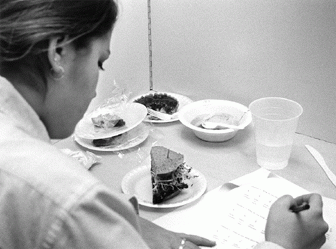For out-of-this-world space habitat menus, Cornell experts develop plant-based foods,such as tofu cheesecake and carrot 'drumsticks'
By Susan S. Lang
After months in a space habitat, astronauts on the moon or Mars will have Cornell to thank if their daily meals are culinary delights.
To help NASA plan the cuisine for future lunar and Martian space colonies, a Cornell chef, nutritionist, food and biological engineer and vegetarian cooking teacher are collaborating to develop and test tasty, nutritious and economical recipes that astronauts can prepare from a limited set of 15 to 30 crops to be grown in future space habitats. Wheat and potatoes are the staples to be complemented with rice, soy and peanuts, salad crops and fresh herbs, all to be grown hydroponically in artificially lit, temperature-controlled space farms.
The fare now being tested at Cornell by weekly taste-testing panels composed of students, faculty and staff includes seitan tacos with lettuce and tomato sprinkled with earthmade cheese, carrot "drumsticks," tempeh sloppy Joes, basil pesto with soy nuts, pasta primavera and tofu cheesecake.
"Our goal is to develop a database of food-processing information and a menu of at least 100 primarily vegetarian recipes of familiar and new menu items based on crops raised in a bioregenerative life support system," said Jean Hunter, associate professor of agricultural and biological engineering at Cornell who is heading up the project.
The team also is developing a food-related decision-making strategy for NASA to use in bioregenerative life support systems for multiyear missions such as a lunar scientific colony or Martian surface exploration. Bioregenerative life support, in which plants and microorganisms regenerate air, water and food for the crew, is envisioned for long-term space exploration, starting 15 to 20 years from now.
"Because the cost of transporting food for these missions will be astronomical, only about 15 percent of calories will be from earthmade foods," added David Levitsky, professor of nutritional sciences and of psychology at Cornell who also is working on the project. "Our dishes, therefore, will typically contain under 10 percent of calories from earthmade foods. These imported foods will probably be the fats, flavor concentrates and various meat and dairy-based foods to be used mostly as condiments as well as a few luxuries, such as chocolate. This will allow the crew to splurge on weekly special meals and a monthly feast, which will be important to break up the monotony and isolation of long-term space travel."
Also working with Hunter and Levitsky are Rupert Spies, a chef and lecturer in food and beverage management in Cornell's School of Hotel Administration who collaborates in recipe development and helps to make the dishes attractive and appealing, and Adriana Rovers, formerly a caterer and teacher of vegetarian cooking who prepares the recipes and runs the tasting panels. Ammar Olabi, a graduate student in food science, is responsible for the database structure of the procedural, sensory, nutritional and cost data for the foods and for statistical analysis of the data.
Graduate students Cheryl Greenwalt and Kenn Dai and undergraduates Mike Tsay and Mark Schroeder also are associated with the project through their research on development of novel food ingredients from residues of farming and food processing in space.
With a three-year grant from NASA, the researchers launched the project six months ago. They now are developing sweeteners and oils from wheat and potatoes, looking both to the past and the future for food-processing approaches. The researchers are looking at 1,000-year-old traditional food-processing strategies as well as turning to their high-tech laboratories. For example, they are using microorganisms to help convert wheat straw and other crop residues into oil, and surplus wheat and potato starch into a sweetener. They also are continually testing recipes with substitutions as needed for ingredients that cannot be provided from Earth or grown in a space colony.
Although several other institutions also are developing foods for space travel, Cornell's project is unique in that it also will include:
- labor and equipment cost analyses for each ingredient and recipe that take into account time, power and space constraints. Costs will be scaled for crew sizes ranging from 4 to 200 persons;
- acceptability ratings of the menu items as assessed by volunteer panels. This will be based not only on weekly taste panels at Cornell but on a four-week controlled study near the end of the project to determine the overall acceptability of the space diet;
- integration of nutrient, cost and acceptability data for individual recipes into an optimization model, which will select low-cost diets for any given mission;
- suggestions for foods and food ingredients necessary to import from Earth and for the selection and development of future food crops for space;
- training of future crew members, space habitat design engineers and food-service personnel at the Johnson Space Center in how to prepare the most appetizing meals with the greatest variety possible within the constraints of a space diet.
"Food plays a critical role in the overall psychological well-being of isolated crews," Levitsky said. "We will, therefore, strive to make the diet familiar to the crew, give them a sense of mastery in preparing the food and a sense of pride or ownership in producing attractive and tasty dishes. We'll focus on these factors in a series of training workshops planned for the third year of the project."
Media Contact
Get Cornell news delivered right to your inbox.
Subscribe
